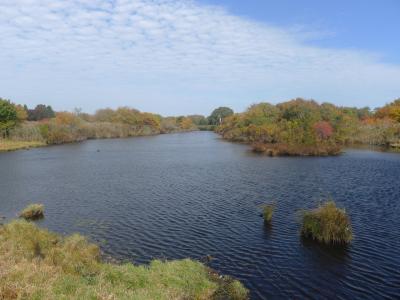Maidstone Pitches Bridge Over Hook Pond

A 352-foot-long bridge that would be 140 feet north of the existing Dunemere Lane bridge across Hook Pond, and more or less parallel to it, drew sharp questions about preservation of the vista and the pond’s water quality when the East Hampton Village Zoning Board of Appeals considered an application from the Maidstone Club on Friday.
Representatives of the club argued that the new bridge, which would connect the second tee of the golf course to its fairway across the pond, would enhance the safety not only of golfers but of pedestrians, cyclists, and motorists, who now share the existing bridge, which is part of the roadway. The proposal calls for a wood bridge to be erected on 42 wood pilings driven a minimum of 11 feet below the pond’s surface, each anchored by poured concrete.
The club seeks a freshwater wetlands permit as well as a permit from the Z.B.A. to construct the bridge, clear vegetation, install paths, and make alterations to a tee box. Also needed would be area variances, because the western end of the bridge would be just eight feet from a village-owned 5.2-acre reserve that contains wetlands, and 50 feet from a private house lot, where the required setback is 55 feet. The project would also require design review board approval.
David Dubin, an attorney representing the club, told board members that a permit examiner and field biologist from the State Department of Environmental Conservation had found that the plans comply with its regulations. Drew Bennett, a consultant for the Maidstone Club, said the bridge would be at a higher elevation than the existing roadway bridge, which, he said, is often flooded.
Lys Marigold, the board’s vice chairwoman, was skeptical. She said turtles sun themselves on rocks and swans nest in the area, “and you want to build a bridge on it, which will alter the view forever for every village inhabitant. Maybe I’m overly involved in this, but I feel passionately that this shouldn’t be allowed to change our scenic vista just for a few golf carts a day.”
Mr. Dubin said the owner of the adjacent private property might have argued that the bridge would have a negative impact, but instead supports the project. Left unsaid was that the adjacent property, on Egypt Lane, is for sale.
Mr. Dubin said the criteria for granting a variance are specific to the neighborhood, not the village as a whole. Renderings of the bridge, which were presented to the board, showed that the bridge would be “not at all adverse or disturbing,” he said.
“These are very romanticized views,” Ms. Marigold said of the renderings. “I’m worried . . . instead of seeing a swan gliding by, seeing a golf cart with people on it, which is a very different vista.” Frank Newbold, the board’s chairman, noted that the village’s historic preservation plan describes private lands with public benefit and the retention of open space. “It’s been an iconic part of East Hampton since the Maidstone was founded in 1891,” he said.
He also referred to the two recently constructed drainage swales in the village, which are intended to intercept pollutants before they reach Hook Pond via runoff from roads, and quoted an editorial in last week’s East Hampton Star. “ ‘The future of our ponds — and drinking water — is at stake,’ ” he read, “ ‘and the public should keep a steady eye’ on proposals that affect the pond.”
Christopher Minardi, a member of the board, agreed. “The pilings and the stress on Hook Pond is something that we really should be careful about,” he said.
Mr. Newbold said the hearing would remain open so that Rob Herrmann, an independent environmental consultant, could review the application. The hearing was tentatively scheduled to resume on Friday, Oct. 28.
In other business at the meeting, five applications were approved. The East Hampton Town Trustees received a freshwater wetlands permit to use village-owned property at the end of Cove Hollow Road for staging and dewatering dredged spoil in connection with a project at Georgica Pond. The trustees are to maintain a project-limiting fence and straw bales around the site, notify the Highway Department at least 48 hours ahead of beginning the work, and repair any damage to the roadway or drainage pipe. A timeframe for the work is dependent on a required D.E.C. permit.
Peter Morton, a cofounder of the Hard Rock Cafe chain, was granted variances to remove a swimming pool and construct a new one within the coastal erosion hazard area at 57 West End Road on the condition that he comply with a protocol to minimize disturbance. Mr. Morton recently rebuilt the historical house on the property, which was destroyed by fire in March 2015.
The board granted Frank Jackson variances to make alterations and additions to the historical timber-frame house at 223 Main Street, to alter an accessory building, and to install a new septic system, all of which fall within wetlands or property-line setbacks. Variances were also granted for the house to exceed the maximum permitted floor area and height. The variances were conditioned on recommendations from the design review board with respect to removal and replacement of any timber framing.
The board granted Thomas Lee variances to allow air-conditioning units, wood decking, walkways, sheds, planters, a wall, and children’s play sets to remain within required setbacks at 43 East Dune Lane, and for structures to cover 128 square feet more than the code allows.
David Gallo of 94 Apaquogue Road was also granted variances. He plans to construct a tennis court that falls within required setbacks and a garage that will be in the front yard, which is typically prohibited.
